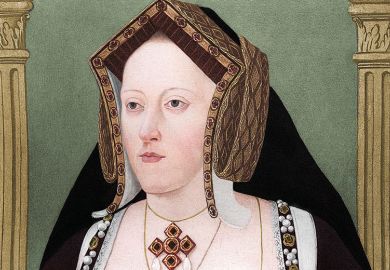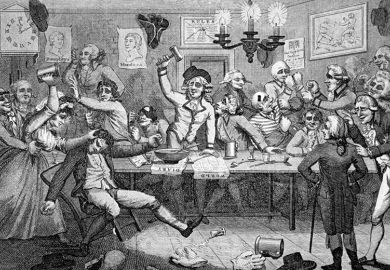In these days of lockdown – when you’ve run out of novels and exhausted Netflix – you could try some longer-established amusements. Elizabeth Charlotte, princess of the Palatinate region of Germany, we read, records “a farting contest between herself, her husband and their son, the future regent. In 1710, she wrote that the king was careful not to fart, but that the dauphin and his wife would do so.” The past is a different country – what a shame! Just imagine how much more consoling the Queen’s recent televised message could have been…
Robert Muchembled, emeritus professor of history at the University of Paris North – Paris 13, is not afraid of the big idea. His past titles have included studies of the Devil, a history of violence and Orgasm and the West: A History of Pleasure from the 16th Century to the Present (which must have required some alluring primary research, not to mention an absorbing grant application). In the manner of Michel Foucault, he is both narrow and broad. Narrow in the sense that his subtitle really ought to read “a cultural history of odours in early modern France”. Nothing wrong with that, but the temptation to assume that French social codes are universal does jeopardise some of his more suggestive conclusions. The habits of early modern France were not – grâce à Dieu – the only way things were done.

On the other hand, again in a typically Foucauldian style, Muchembled often falls back on the heaving generalisation, where the lack of supporting evidence can lead to omnivorous assertions such as “French adults, whatever their social class, showed no signs of anal or sexual repression” or, with an even more grandiloquent sweep, “For the past two or three millennia, women have been accused of smelling worse than men.”
It is extremely difficult to evoke a particular smell in words, and attempts can lead to the sorts of bizarre bullshit worthy of the most pretentious sommelier: “a vintage with hints of nutmeg and kipper and a buttery finish” or “a winsome, youthful grape with intimations of the forest floor” and so on. It is even more of a challenge to describe the pongs of the past. Muchembled cites the American psychologist Rachel Herz, whose taxonomy of aromas is startlingly straightforward (well, the first four terms are, anyway): “salty, sweet, acid, bitter and umami”. The fifth term drove me to the internet, but, having been told it is characterised by “ribonucleotides, including inosinate and guanylate”, I’m none the wiser.
In spite of (or perhaps because of) these difficulties, Smells is an enthralling book and one that brilliantly unfolds its central thesis: “our sense of smell is entirely shaped by cultural phenomena arising as a result of specific historical processes”. There is nothing suprahistorical about smell because – perhaps unlike the other senses – smell is empirical, learned, developed through practice (in both senses), and this practice is, obviously, inseparable from our lived experience, our cultural situatedness, our, as it were, surrounding smellscape.
Muchembled (following notably Freud and Norman O. Brown) argues that odorous repugnance is acquired, pointing out that the early moderns “showed little disgust at faeces and urine, whether human or animal; indeed both were widely used in medicine and beauty treatments”. Jean de Renou in 1624 described the commonplace tradition of “using rat droppings to treat kidney stones, dog dirt for throat infections, and peacock droppings for ‘falling sickness’ (epilepsy), while human excrement was ‘marvellously suppurative’”. Urine was commonly used as a moisturiser: in 1666, Marie Meurdrac’s prescriptions to treat dry skin included “urine from a young person who drinks nothing but wine”. In 1775, the unlikely sounding Polycarpe Poncelet “published a recipe for a cheap and excellent liqueur that simply required distilling a ripe cow pat in brandy”. Part of the charm of Muchembled’s book is its descriptions of these outlandish remedies, tinctures and pick-me-ups as well as its redolent elicitation of the full-bodied conditions of early modern behaviours: “In 1529, a peasant woman quarrelling with a man shouted in exasperation that she was not afraid of him: ‘I’d boldly show you my arse if it wasn’t all shitty!’”
But Smells is so much more than a canter through the amusing crudities of our allegedly unsophisticated forebears. Muchembled identifies a cultural shift occurring in France around 1620 that sees the emergence of “a vigorously moralising understanding of human existence that sought to suppress every trace of man’s animal nature”. He describes a growing tension during the period between the omnipresence of noisome putrefaction and “the slowly emerging expectation that lower bodily functions should not be mentioned in polite society”. The causes of this shift in mores are several, overlapping and not uncontentious. Obviously, the rise of scientific knowledge, especially medical know-how, led to a diminution of quack cures and reliance on their stomach-churning ingredients. But there were also powerful secular and epistemological developments that meant that the influence of the Devil (and his accompanying stench) began to dwindle.

One of the most commonplace conceptions regarding plague was that it was the mephitic outpouring of Satan. As Muchembled puts it, “The stench of the Devil’s breath killed people.” The measures he describes to prevent contagion have, of late, become eerily familiar: “A safe distance was to be maintained in case of interaction with a patient. In Arras, it was clearly defined in 1597 by the rule stipulating patients must carry a white rod measuring some two metres in length.” Galen, Marsilio Ficino and Ambroise Paré all, at their various times, championed the connection between putrefaction and plague, and one of the best ways to take on miasma was to fight fire with fire. Thus it was, we are told, that the population “sniffed rotting cheese, drank their own urine, bred goats to keep their homes safe, and breathed in the air from privies first thing in the morning on an empty stomach. One German doctor was still recommending privy-sniffing as late as 1680.” As outbreaks of the plague waned, reliance on such disgusting prophylactics correspondingly tailed off.
Strong perfumes based on civet, musk and ambergris were gradually displaced by lighter floral fragrances – citrus, bergamot, orange flower water, almond, jasmine and lavender. A new stress on (moral) cleanliness demanded that epicentres of nauseating stink – the slaughterhouse and the graveyard – be relocated to the city’s margins. A developing economy gave rise, Muchembled tells us, to “a love of fine cuisine and exotic aromas shipped in from France’s colonial empire”. A gradual return of bathhouses and washing encouraged a new perception of the body that emphasised its aesthetic and sexual promise rather than regarding it as a seat of inevitable corruption. Domestic bathtubs were seen as indicative of cultural sophistication and material prosperity.
But what sounds like progress in the curbing of stench might turn out to be merely an excess of embarrassment, a repression of physicality and, towards the end of this gripping book, Muchembled turns his attention to the contemporary attempts to erase the body altogether. The “Californian cult of the body beautiful”, completely hairless and scentless – fetishised by its own somatic absence – speaks to a sort of squeamish modernity that utterly denies physical degeneration and decay. While not (unsurprisingly) entirely successful, Zoologist Perfumes’ products based on civet, panda, rhinoceros and other animals suggest an atavistic desire to abandon such manic sterility. In the wake of the Covid-19 pandemic, it will be interesting to see how the company’s bat fragrance competes.
Peter J. Smith is reader in Renaissance literature at Nottingham Trent University. He is the author of Social Shakespeare (1995) and Between Two Stools: Scatology and its Representations in English Literature, Chaucer to Swift (2012). His essay on flatulence in King Lear appeared in the most recent volume of Shakespeare Survey.
Smells: A Cultural History of Odours in Early Modern Times
By Robert Muchembled; translated by Susan Pickford
Polity, 260pp, £50.00
ISBN 9781509536771
Published 15 May 2020
The author
Robert Muchembled, emeritus professor of history at the University of Paris, was born in Pas-de-Calais, France, the son of a miner and a peasant farmer, and spoke only the local Picardy dialect until he began school. He studied at the University of Lille, went on to a doctorate at the Sorbonne University and has spent extended periods at both Princeton University’s Davis Center and the Princeton Institute for Advanced Study.
His initial research was on the homicidal violence of young peasants in the Artois, the area where he grew up, between 1400 and 1660. He has little time for “bourgeois history”, he says, and has been passionately interested only in topics relating to his own “deep rural and mining background”. He has, therefore, looked “under the smooth surface of official accounts” and “tried to give back a voice to marginal and exploited people – perhaps as a way of repaying my debt for the comfortable life that my university career has given me”. As he has tried to solve a series of mysteries, his career has led him, for example, from the history of women to the history of orgasm, and then from an “iconoclastic biography” of Madame de Pompadour (chief mistress and court favourite of Louis XV) to Smells, because she “adored ceramic flowers drenched in perfume”.
History, in Muchembled’s view, offers us neither “a static museum” nor “some ‘good old days’ we can be nostalgic about” but instead “an introduction to the present: all my books start with current issues, of which I retrace the threads only to come back and better understand our own troubled era”. Stuck in New York since March, he sees in the Covid-19 crisis many echoes of earlier responses to the plague, when “very rich people took refuge in the countryside” while the poor merely “hoped to get through it without starving”.
Matthew Reisz
POSTSCRIPT:
Print headline: A fragrant past corked by polite society
Register to continue
Why register?
- Registration is free and only takes a moment
- Once registered, you can read 3 articles a month
- Sign up for our newsletter
Subscribe
Or subscribe for unlimited access to:
- Unlimited access to news, views, insights & reviews
- Digital editions
- Digital access to THE’s university and college rankings analysis
Already registered or a current subscriber? Login








